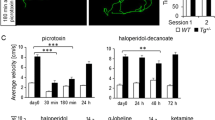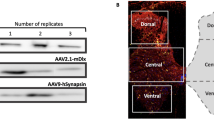Abstract
We investigated the neuron-specific enolase (NSE) promoter in terms of its promoter strength and neuronal specificity in the cerebellum in vivo. The 1.8 kb rat NSE promoter was divided into three regions, A (0.8 kb), B (0.7 kb), and C (0.3 kb), starting from the 5′ side. Then, we made various deletion constructs and assessed them by virally expressing GFP under the control of one of the deleted promoters. Removing region A reduced GFP expression to ~6% of that of the original 1.8 kb promoter. Further deletion of region B (presence of region C alone) did not influence the promoter strength, but removing region B from the original 1.8 kb promoter reduced the GFP expression to ~6% of the original level, similar to the level observed after deletion of region A. Immunohistochemistry showed robust GFP expression in Purkinje cells and modest expression in interneurons by the original promoter. Removing region A and/or region B abolished the GFP expression in Purkinje cells in most cerebellar lobules, with the expression in interneurons almost unchanged. These results suggest that region C, which is a proximal 0.3 kb sequence, contains cis-acting elements that drive transcription predominantly in interneurons. The addition of either region A or B onto region C does not alter the promoter properties; however, the addition of both regions A and B to region C drastically enhanced the promoter activity in Purkinje cells, suggesting the synergistic action of cis-acting regulatory elements in regions A and B for strong activation in Purkinje cells.





Similar content being viewed by others
Reference
Sakimura K, Kushiya E, Obinata M, Odani S, Takahashi Y. Molecular cloning and the nucleotide sequence of cDNA for neuron-specific enolase messenger RNA of rat brain. Proc Natl Acad Sci U S A. 1985;82:7453–7.
Forss-Petter S, Danielson P, Sutcliffe JG. Neuron-specific enolase: complete structure of rat mRNA, multiple transcriptional start sites, and evidence suggesting post-transcriptional control. J Neurosci Res. 1986;16:141–56. doi:10.1002/jnr.490160114.
Forss-Petter S, Danielson PE, Catsicas S, Battenberg E, Price J, Nerenberg M, Sutcliffe JG. Transgenic mice expressing beta-galactosidase in mature neurons under neuron-specific enolase promoter control. Neuron. 1990;5:187–97.
Bao X, Pal R, Hascup KN, Wang Y, Wang WT, Xu W, Hui D, Agbas A, Wang X, Michaelis ML, Choi IY, Belousov AB, Gerhardt GA, Michaelis EK. Transgenic expression of Glud1 (glutamate dehydrogenase 1) in neurons: in vivo model of enhanced glutamate release, altered synaptic plasticity, and selective neuronal vulnerability. J Neurosci: Offic J Soc Neurosci. 2009;29:13929–44. doi:10.1523/jneurosci.4413-09.2009.
Bian M, Liu J, Hong X, Yu M, Huang Y, Sheng Z, Fei J, Huang F. Overexpression of parkin ameliorates dopaminergic neurodegeneration induced by 1- methyl-4-phenyl-1,2,3,6-tetrahydropyridine in mice. PLoS One. 2012;7:e39953. doi:10.1371/journal.pone.0039953.
Levy YS, Merims D, Panet H, Barhum Y, Melamed E, Offen D. Induction of neuron-specific enolase promoter and neuronal markers in differentiated mouse bone marrow stromal cells. J Mol Neurosci: MN. 2003;21:121–32. doi:10.1385/JMN:21:2:121.
Parkinson FE, Xiong W, Zamzow CR, Chestley T, Mizuno T, Duckworth ML. Transgenic expression of human equilibrative nucleoside transporter 1 in mouse neurons. J Neurochem. 2009;109:562–72. doi:10.1111/j.1471-4159.2009.05991.x.
Pohlkamp T, Steller L, May P, Gunther T, Schule R, Frotscher M, Herz J, Bock HH. Generation and characterization of an Nse-CreERT2 transgenic line suitable for inducible gene manipulation in cerebellar granule cells. PLoS One. 2014;9:e100384. doi:10.1371/journal.pone.0100384.
Sakimura K, Kushiya E, Ogura A, Kudo Y, Katagiri T, Takahashi Y. Upstream and intron regulatory regions for expression of the rat neuron-specific enolase gene. Brain Res Mol Brain Res. 1995;28:19–28.
Twyman RM, Jones EA. Sequences in the proximal 5′ flanking region of the rat neuron-specific enolase (NSE) gene are sufficient for cell type-specific reporter gene expression. J Mol Neurosci : MN. 1997;8:63–73. doi:10.1007/bf02736864.
Blessing D, Deglon N. Adeno-associated virus and lentivirus vectors: a refined toolkit for the central nervous system. Curr Opin Virol. 2016;21:61–6. doi:10.1016/j.coviro.2016.08.004.
Huda F, Konno A, Matsuzaki Y, Goenawan H, Miyake K, Shimada T, Hirai H. Distinct transduction profiles in the CNS via three injection routes of AAV9 and the application to generation of a neurodegenerative mouse model. Mol Therapy Methods Clin Dev. 2014;1:14032. doi:10.1038/mtm.2014.32.
Miyake K, Miyake N, Yamazaki Y, Shimada T, Hirai Y. Serotype-independent method of recombinant adeno-associated virus (AAV) vector production and purification. Journal of Nippon Medical School = Nippon Ika Daigaku zasshi. 2012;79:394–402.
Huda F, Fan Y, Suzuki M, Konno A, Matsuzaki Y, Takahashi N, Chan JK, Hirai H. Fusion of human fetal mesenchymal stem cells with “degenerating” cerebellar neurons in spinocerebellar ataxia type 1 model mice. PLoS One. 2016;11:e0164202. doi:10.1371/journal.pone.0164202.
Matsuzaki Y, Konno A, Mukai R, Honda F, Hirato M, Yoshimoto Y, Hirai H. Transduction profile of the marmoset central nervous system using adeno-associated virus serotype 9 vectors. Mol Neurobiol. 2016; doi:10.1007/s12035-016-9777-6.
Shinohara Y, Konno A, Takahashi N, Matsuzaki Y, Kishi S, Hirai H. Viral vector-based dissection of marmoset GFAP promoter in mouse and marmoset brains. PLoS One. 2016;11:e0162023. doi:10.1371/journal.pone.0162023.
Imagawa M, Chiu R, Karin M. Transcription factor AP-2 mediates induction by two different signal-transduction pathways: protein kinase C and cAMP. Cell. 1987;51:251–60.
Desmarais D, Filion M, Lapointe L, Royal A. Cell-specific transcription of the peripherin gene in neuronal cell lines involves a cis-acting element surrounding the TATA box. EMBO J. 1992;11:2971–80.
Sawada Y, Konno A, Nagaoka J, Hirai H. Inflammation-induced reversible switch of the neuron-specific enolase promoter from Purkinje neurons to Bergmann glia. Sci Rep. 2016;6:27758. doi:10.1038/srep27758.
Acknowledgments
The authors thank Asako Ohnishi and Junko Sugiyama for AAV9 vector production and maintenance of mice. This study was (partially) supported by the program for Brain Mapping by Integrated Neurotechnologies for Disease Studies (Brain/MINDS) from the Ministry of Education, Culture, and Sports Science (MEXT) and the Japan Agency for Medical Research and Development (AMED) and Gunma University Initiative for Advanced Research (GIAR) (to H. Hirai); and JSPS KAKENHI grant no. 15K18330 (to A. Konno).
Author information
Authors and Affiliations
Corresponding author
Ethics declarations
Conflicts of Interest
The authors declare that they have no conflicts of interest.
Rights and permissions
About this article
Cite this article
Shinohara, Y., Ohtani, T., Konno, A. et al. Viral Vector-Based Evaluation of Regulatory Regions in the Neuron-Specific Enolase (NSE) Promoter in Mouse Cerebellum In Vivo. Cerebellum 16, 913–922 (2017). https://doi.org/10.1007/s12311-017-0866-5
Published:
Issue Date:
DOI: https://doi.org/10.1007/s12311-017-0866-5




